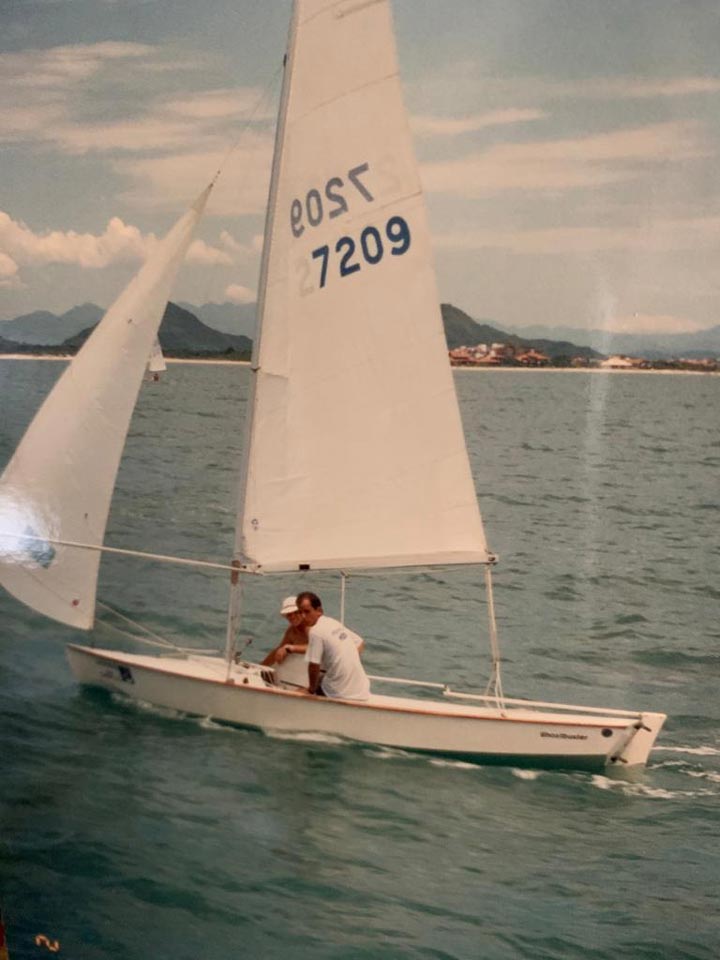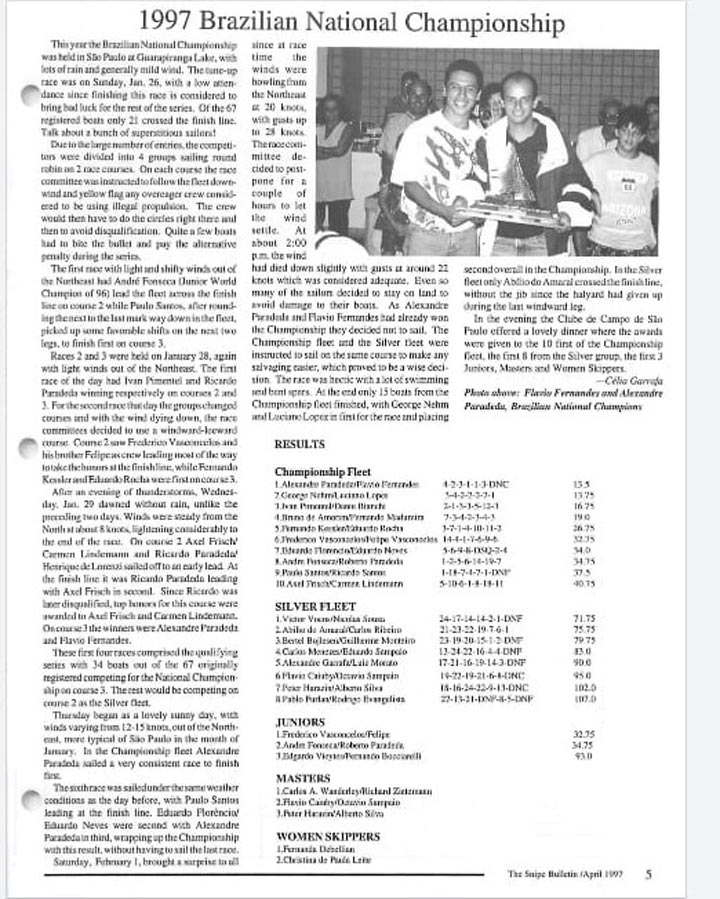Quantum sail consultant, sailmaker, and accomplished Snipe sailor, Xandi Paradeda, reflects on the development of the Snipe class over the last thirty years and gives insight into the sail design and testing process.
I started sailing Snipes in 1988, more than 30 years ago. At that time, there was no standard boat or mast like there is today. Many sailors used handmade wooden hulls from a variety of manufacturers, each hull different from the next.
Thor was the strongest Brazilian boat builder, and their revolutionary closed cockpit design changed the class forever. Thor spent years working to create one of the best boats in the world, both in layout optimization and construction quality. Many boats of this generation are still competing on the national scene and can be just as quick as newer boats.
Standardizing masts was another challenge in this class. Inconsistencies in aluminum alloy from the same supplier and the difficulty of the anodizing process created an immense challenge. Limited spreader adjustments and the lack of stay tension equipment only added to the challenge of standardization. Consequently, it was almost impossible for the sails to follow a pattern, as each mast required a different sail design.
It was difficult to be a beginner at that time because we could not copy the best sailors. Torben Grael, Paulo Santos, Marco Aurélio Paradeda, Boris Ostergren, and Ivan Pimentel−no one had the same equipment, tuning guide, or material guide.

I won my first Brazilian nationals in 1992, at Lake Guarapiranga in São Paulo. I used the BRA 12115 hull, which had already made history through the accomplishments of helmsmen Nelson Piccolo and Marco Aurélio Paradeda, who had won all possible titles in the class. I believe that sailing with BRA 12115 helped me achieve the results I did in the class. The 12,000 series had a very thin bow, which proved to be an advantage with the low wave conditions on Lake Guarapiranga. Old boats also did not measure the “moment of inertia” and had a flat hull, which again were advantageous for the venue. Although the boat was almost falling apart, it remained fast and competitive until that year. Winning the 1992 nationals was a great result for a wooden hull built for the 1959 World Championship in Porto Alegre, Brazil.
When Snipe standardization began in Brazil, the vast majority of sailors used Thor boats with Lemão masts. At this time, North Sails and Nils Ostergren Sails dominated the national sails market, and it became possible to “copy” the equipment that the fastest sailors were using.
In 1993, the Snipe World Championship was again held in Porto Alegre, Brazil, 34 years after the 1959 World Championship. I was able to see newer fiberglass Persson boats with a thick bow, optimized layout, and Proctor rigging with length and opening adjustment for the spreaders. These boats opened my horizons because my biggest competitors in Brazil did not care much about what hull number your boat was. They were guys who sailed very well and spent many hours training but did not place enough importance on equipment development and regulation.
Over the next few years, I developed tuning guides for spreader adjustments, mast chock, rake, and tension. Back then, rake used to be measured twice: first with an initial slight forward push on the mast and then again as a final rake. The difference in the two rakes was the tension, and the tension was always 12 centimeters. The lateral stay stretched position was very sensitive; usually the same crew member pulled the forestay.
In those days, I had a Chilean-made Persson boat, Proctor standard mast, and North sails. The mast was stiff and uncomfortable in the light wind. We won the Brazilian Championship in 1995, 1996, and 1997. The hours I spent training during that time shaped how I sail Snipes today.
In 1997, the first Lemão-built boats with thick bows appeared–a trend first initiated by Persson hulls that is still followed today. These Brazilian boats, which had a competitive price and were compatible with South American market, helped to make Lemão one of the largest boat builders in the world.
In the 90s, I sailed in the 470 class as well. The 470 is extremely sensitive to rig tune and has many variables that must be adjusted in each small wind variation. My crew was Bernardo Arndt (Baby), who had already participated in the Olympics in Barcelona. He helped me develop my ability to regulate the boat and read the sails. Since we were racing in the Olympic class, we competed often and I was able to add experience and develop my sailing skills quickly.
In 1997, the Snipe World Championship was held in San Diego, California, and it brought together lofts from some of the largest sail brands in the world. San Diego is also a renowned location to race for inshore one-design classes. It was there that I met and was well received by fellow Brazilian Rodrigo Meirelles (Aspirina), a who worked as a sailmaker for North Sails. I already had some sails knowledge and could share my feedback about sail design and development. During this period, we used softer masts, like Sidewinder Junior, and since the stiffness of the mast aggressively modifies the shape of the sails, sail designs had to be changed. San Diego has always been a great place to test light wind sails for both North Sails and Quantum Sails, and our job was to balance sail designs to be fast in light, medium, and strong winds. We had to adapt to the soft mast, and we continued to use this mast until 2000. The soft masts and light stay tension led to a significant decrease in crew weight. In those days it was normal to go sailing with 130 kilos of total crew weight. When it was my period as Vice Champion of Snipe Worlds, Pan Americans, and Western Hemisphere, I decided it could not stay like this.

In 2000, in partnership with my great friend Rique Wanderley, we acquired a Danish-made Persson hull and a stiff Proctor standard mast. Yet another mast change. I called Rodrigo Meirelles and asked him to find a boat for that mast, as we were heading to Midwinters in the USA to develop the sails for the Snipe World Championship taking place the following year in Punta del Este, Uruguay. Chris Snow stayed with us during the three-week event. In each Midwinter event, we made some sail changes. It was my first long-term development work. In December, we won the Snipe World Championship without even sailing the last race.
In 2003, a very well-made sail appeared on the market. It was made in Rio de Janeiro. Ricardo Lobato (Blu) was the sail designer and Bruno Bethlem the main sailor. They were creating sails at Quantum Sails Brazil with a sail design following an emerging new trend. That year there was a big change in snipe regulation, and, in response, we started to use a lot more tension in the stays. But I was late to make this change and did not adapt at the speed I should have. That was a lesson that I have never forgotten. We made some changes to meet the new regulations after the Snipe World Championship in Sweden in 2003, and the tension gauge equipment became an essential part of the Snipe sailor’s life. Stays with a lot of tension and stiffer masts increased the crew weights to 140 kilos or more.
In those days, my brother Roberto Paradeda and I started to work with Olimpic Sails, a respected Italian sail brand in the Optimist, 420, and 470. We started the Snipe sails development process in 2003, and that same year we used the Sidewinder Gold mast for the first time at the Snipe World Championship in Sweden. At the time, many sailors had begun to have access to good sails and equipment in South America. In Brazil, we had access to Quantum Sails Brazil, Olimpic Sails, North Sails, Lemão boats, and Lemão and Sidewinder masts.
With increased access to quality suppliers, the development with Olimpic Sails was promising, and there was a great collaboration in Brazil with us; Renzo, the Olimpic sail designer; and the Olimpic Sails owners, who had a great passion for the Snipe Class. In 2004, we won the Hemisphere, and in 2007 we won the Pan-American games.
With my brothers Roberto and Ricardo, we opened Olimpic Sails Brazil. Finally, we had a sail loft in our hometown of Porto Alegre, Brazil. I now had a factory in my home to speed up the sail development and make them for the market. At that time, Bruno Bethlem had already joined our team, and we collaborated on sail development that became a worldwide standard. With the Sidewinder Gold mast and Olimpic Sails, we won three consecutive Snipe Worlds Championship in 2011, 2013, and 2015, each year with a different crew.
It was at Olimpic Sails that we started the process of deepening the draft of the sails at the top and flattening the lower part, the opposite of what the European and San Diego schools had done for years. Only sails made in Argentina had some deep options in the top, but that was lost because of their huge variety of models and versions.
When our loft started working with Quantum Sails in 2016, we were excited for the collaboration, since existing Quantum Snipe sails had a great reputation in the class. Quantum’s George Szabo and Roberto Paradeda put a lot of time and effort into sail development, promoting changes that would continue to please both North American and South American sailors. After tireless hours of work on the design software, changes in the sail loft, and water tests, we developed competitive sails for the Snipe World Championship in Valencia, Spain. The semi-radial models were fast and perfect for the conditions at that venue, but, unfortunately, our sails did not win the world title as they had been since 2009.
We returned to Brazil and continued working hard on sail development, building a flatter model that would require more open spreaders in the strong wind and more closed spreaders in the light wind. The flatter sail performed better in light winds. The initial P4 mainsail model used the spreaders in a closed position on the Sidewinder Gold mast and performed well in medium and strong winds, but performed poorly in light wind, so we began modifications again.
With great support from Bruno Bethlem, George Szabo, and Roberto Paradeda, the C5 model was built and improved upon the P4. The C5 performed better in light wind because of the closed spreaders allowing the leech to open in. In strong wind, we opened the spreaders and did not lose performance against the “P4” model. After all this work, we tested the model in the Snipe Brazilian Championship in São Paulo, an event with light wind and flat water. The sail for the 2019 Snipe World Championship in Ilhabela, Brazil, was born. Brazilian-made sails won the World title once again! We also won second and fourth places at this event, in addition to the World Junior title.
Sails are a matter of personal taste. When you use a sail, you must feel good with it. I believe that everyone has their individual tastes and characteristics developed over years of training. The sailor’s equipment and adjustments should help the sailor perform better. Respect your individuality as sailors, and we, as sailmakers, will always try to make your job easier by providing information and support.